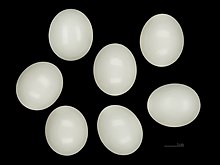Bee eater (species)
| Bee-eater | ||||||||||
|---|---|---|---|---|---|---|---|---|---|---|

Bee-eater ( Merops apiaster ) |
||||||||||
| Systematics | ||||||||||
|
||||||||||
| Scientific name | ||||||||||
| Merops apiaster | ||||||||||
| Linnaeus , 1758 |
The bee-eater ( Merops apiaster ), seldom also - incorrectly because it does not belong to the woodpeckers - called " bee woodpecker ", is a strikingly colorful bird from the bee-eater family (Meropidae) of the same name . It is one of the migratory birds that overwinter in Africa .
Appearance
The bee-eater, which is around 28 centimeters on average, is one of the most colorful, hardly to be confused birds in Europe. The belly and chest area is turquoise, the vertex, neck and back areas are rust-brown, the wings are also, and there is a black eye stripe above the yellowish chin. Further features are the long, slightly curved beak and the elongated central tail feathers, also known as tail skewers , only present in adult birds . The young birds, which are generally paler in color, have an additional greenish tint on their backs and wing covers, from brownish gray to dirty sand colors.
distribution and habitat
The bee eater prefers warm climates. Its distribution area extends from south-west and the Middle East, north-west Africa and south and south-east Europe northwards to south-east Poland. In Germany it was considered extinct at the end of the 1980s, but has been immigrating again since 1990. It settled in the area around the Kaiserstuhl in Germany at the beginning of the 21st century . In 2015, half of the approx. 1000 breeding pairs in Germany lived in southern Saxony-Anhalt near Merseburg . In the same year, a small population appeared in the Viersen district on the left Lower Rhine. The bee eater can also be found in the northern Kraichgau .
His habitat are open landscapes with individual trees and bushes. It breeds on steep slopes on the banks of rivers or lakes, as well as clay walls created by mining.
behavior
Bee-eaters are often found in colonies. They like to sit, usually together with their fellow species, on protruding branches, wires and masts. They are very good fliers, but look rather clumsy on the ground.
nutrition
In flight, the bee-eater mainly preyes on hymenoptera bees , wasps , bumblebees , hornets , but also dragonflies , cicadas and flying beetles . Since many are defensive, he first flies to a nearby seat guard after catching the insect . There it is killed with strong blows on the base and kneaded, whereby the poison gland of the sting empties. Only then is the prey swallowed or passed on to the young.
voice
Bee-eaters are call-happy birds. The most common call is a hoarse “prürr” or “krük krük”, which is often varied. The alarm call is "pitt-pitt-pitt".
Reproduction
The bee eater is a colony breeder . The nest is dug as a breeding cave in the slopes and walls of steep banks or sand pits, whereby the breeding pairs place these fairly close together. However, individual breeding pairs have also been observed, particularly on the edge of the distribution area. Such pioneer settlements either soon disappear or quickly expand into breeding colonies.
The tubes are usually 1.0 to 1.5 meters, in extreme cases up to 2.7 meters long with a diameter of 4 to 5 centimeters, with the entrance hole measuring around 8 to 10 centimeters. At the end of the tube there is the bubble-shaped brood chamber. In addition to the inhabited tubes, which are usually several meters apart, there are often other unfinished tubes. The couple's digging work is completed in around two to three weeks.
The breeding season begins in mid-May after returning from Africa and lasts including rearing until the end of July, the breeding itself lasts about 20 to 22 days. There is only one brood per year (no offspring). Both sexes take part in breeding, but the male to a lesser extent. The clutch consists of five to seven almost spherical, pure white, smooth, shiny eggs measuring 22.5 to 29.5 by 17.6 to 23.6 millimeters, with the eggs lying directly on the floor of the brood chamber. The number of eggs is heavily dependent on the food available. On the floor of the incubation chamber, a centimeter-high layer is created in the course of the hatchery by spitting balls of insect remains as well as excrement and other waste.
The nestlings are naked with pink skin. The beak of the young is gray with very narrow yellowish marginal ridges. The young birds are looked after in the nest by both parents for 20 to 30 days and for a while afterwards.
Web links
- Merops apiaster in the endangered Red List species the IUCN 2008. Posted by: BirdLife International, 2008. Accessed on December 18 of 2008.
- Videos, photos and sound recordings of Merops apiaster in the Internet Bird Collection
- NABU Baden-Württemberg ( Memento from January 18, 2006 in the Internet Archive )
- Age and gender characteristics (PDF; 5.4 MB) by J. Blasco-Zumeta and G.-M. Heinze (Eng.)
- Bee-eater's feathers
Individual evidence
- ↑ a b c Endangered animals in our homeland. Bee-eater - Merops apiaster . From: Pro Biodiversity Foundation, Bielefeld (single sheet)
- ↑ a b Svensson, L .; Grant, PJ; Mullarney, K .; Zetterström, D .: The new cosmos bird guide - all species of Europe, North Africa and the Middle East. Franckh-Kosmos Verlags-GmbH & Co., Stuttgart. 1999. ISBN 3-440-07720-9 , p. 222
- ↑ Mitteldeutsche Zeitung online edition from August 16, 2015
- ↑ http://www.vogelmeldung.de/public/index.html?detail=99637&vogelart_id=&nummer_id=20&gemeinde_id=&limit_anfang=0&von=01.01.2005&bis=08.08.2015&suche=#a99637
- ↑ HeidelbergCement AG: Bienenfresser - dazzling fliers on the road to success
- ^ Günter Hack: Wind in the form of a bee eater. In: Merkur 67,5 (May 2013), pp. 472–475, here p. 474.



